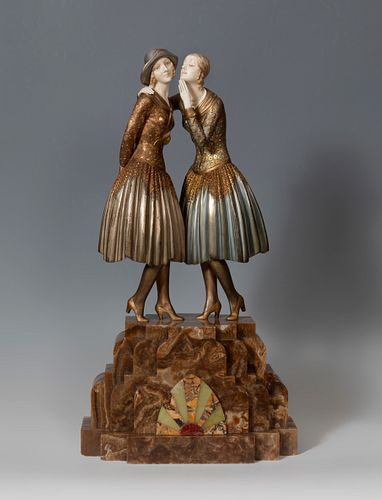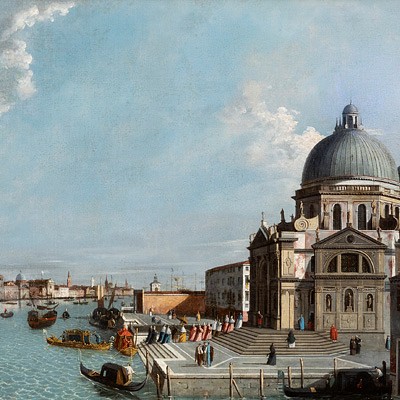DEMÉTRE CHIPARUS (Romania, 1886 - France, 1947). "The secret". Chryselephantine sculpture in patinated bronze and ivory with an onyx base. Signed.
Lot 50
About Seller
Setdart Auction House
Carrer Aragó 346
Barcelona
Spain
Setdart Subastas was born in 2004 and is currently the first online art auction in Spain with solidity, prestige and reliability guaranteed by our more than 60,000 users. Setdart has a young, dynamic and enterprising team ready to successfully manage the purchase and sale of art works through custom...Read more
Categories
Estimate:
EUR€40,000 - EUR€50,000
$43,010.75 - $53,763.44
Absentee vs Live bid
Two ways to bid:
- Leave a max absentee bid and the platform will bid on your behalf up to your maximum bid during the live auction.
- Bid live during the auction and your bids will be submitted real-time to the auctioneer.
Bid Increments
| Price | Bid Increment |
|---|---|
| EUR€0 | EUR€10 |
| EUR€200 | EUR€25 |
| EUR€500 | EUR€50 |
| EUR€1,000 | EUR€100 |
| EUR€3,000 | EUR€200 |
| EUR€5,000 | EUR€500 |
| EUR€10,000 | EUR€1,000 |
| EUR€20,000 | EUR€2,000 |
| EUR€50,000 | EUR€5,000 |
About Auction
By Setdart Auction House
May 18, 2021
Set Reminder
2021-05-18 09:30:00
2021-05-18 09:30:00
America/New_York
Bidsquare
Bidsquare : Classics XIX and XX
https://www.bidsquare.com/auctions/setdart-auction-house/classics-xix-and-xx-6961
The next 18th May there will be a 19th and 20th Century Classics Auction at Setdart.com There will be a select repertoire of important artists such as Carlos Cruz Diez, Luis Feito, Joan Miró, Fernando Botero, Josep Llimona, Salvador Dalí among others. Setdart Auction House sofia@setdart.com
The next 18th May there will be a 19th and 20th Century Classics Auction at Setdart.com There will be a select repertoire of important artists such as Carlos Cruz Diez, Luis Feito, Joan Miró, Fernando Botero, Josep Llimona, Salvador Dalí among others. Setdart Auction House sofia@setdart.com
- Lot Description
DEMÉTRE CHIPARUS (Romania, 1886 - France, 1947). "The secret". Chryselephantine sculpture in patinated bronze and ivory with an onyx base. Signed. Foundry stamp. Measurements: 37 cm. alt. figures; 55.5 x 30 x 12 cm (total). Chiparus specialized in chryselephantine sculptures with which he reached a high artistic level, through an exquisite work of materials, achieving contrasting textures and qualities, and also excelling in the formal aspect. In this work, the flesh tones are kept in ivory, delicately carved, and the bodies are in bronze, with details in relief, reproducing the different tones of the clothing. The stepped pedestal is made of onyx. Two graceful girls, with the gestures of dancers, approach each other to exchange confidences. They wear skirts with pleated skirts alternating with gold trimmed areas. The brocades of the blouses and the high heels are also golden. They look like twins in physique and costume, except that one of them covers her ringlets with a hat. The stylized and flexible canons are characteristic of this author.Born in Dorohoi, Romania, Chiparus is currently the most appreciated sculptor of the Art Deco period. He began his training in 1909 in Italy, where he was taught by the sculptor Raffaello Romanelli. In 1912 he moved to Paris and entered the Ecole des Beaux-Arts, where his teachers were Antonin Mercie and Jean Boucher. Chiparus exhibited his first works, in a realistic style, at the Paris Salon of 1914. He already used a combination of materials, bronze and ivory, which from then on would be frequent in his production. A sculptor in the Art Deco style, he produced his best works between 1914 and 1933. His sculptures were admired for their brilliant decorative effect and originality, as well as for the attractiveness of their subjects. Chiparus was inspired by Russian ballets, French theater and early motion pictures to create his elegant figures with graceful movement and dynamic composition. Another of his main influences was ancient Egypt, following the discovery and excavation of the tomb of Tuntankhamon. Throughout his career he exhibited only occasionally at the Paris Salon, and during World War II he was forced to interrupt his production. By the early 1940s his work had virtually no audience, but the artist continued to sculpt for himself, making animal figures in the Art Deco style. In 1942 and 1943, Chiparus exhibited his sculptures "Polar Bear", "American Bison" and "Pelican" at the Salon. Dimitri Chiparus is currently represented in the Musée d'Orsay in Paris and the Musée d'Art Nouveau and Art Deco Casa Lis in Salamanca, among others, as well as in prominent private collections around the world. The name "chryselephantine" refers to the Greek sculptor Phidias, who in the 5th century B.C. directed the works of the Parthenon and sculpted one of his famous statues dedicated to Athena in gold and ivory. Etymologically the word comes from Greek ("chrysos": gold and "elephas": ivory). Ivory has been used for the realization of works of art throughout all cultures and civilizations, but during the 19th century its use had been reduced to small decorative objects. A historical circumstance changed this trend: the annexation of the Congo by the Kingdom of Belgium and the massive exploitation of the resources of this new colony led to the accumulation of large quantities of ivory tusks in the warehouses of the metropolis.
- Shipping Info
-
In-House Shipping
-
- Buyer's Premium



 EUR
EUR CAD
CAD AUD
AUD GBP
GBP MXN
MXN HKD
HKD CNY
CNY MYR
MYR SEK
SEK SGD
SGD CHF
CHF THB
THB



















